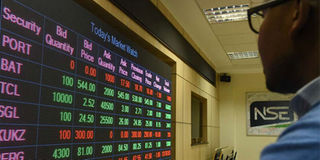Premium
NSE turnover drops by 30pc in second quarter

Nairobi Securities Exchange trading floor. PHOTO | DIANA NGILA | NMG
What you need to know:
- Average daily traded turnover in the market declined from Sh780 million in Q2 of 2018 to Sh539 million this year.
- The fall in turnover is a threat to the revenue of market intermediaries who earn a commission on the trades handled.
- Stockbrokers are allowed to charge up to 2.1 percent in commission per trade but trades are realistically charged a lower rate due to discounts and competition for business.
Turnover at the Nairobi Securities Exchange (NSE) fell by 30 percent to Sh32.9 billion in the second quarter of the year compared to a similar period in 2018 as tumbling share prices discouraged trading.
Market data compiled by Standard Investment Bank (SIB) shows the average daily traded turnover in the market declined from Sh780 million in the second quarter of 2018 to Sh539 million this year, with local participation in the market declining.
The fall in turnover is a threat to the revenue of market intermediaries who earn a commission on the trades handled.
Stockbrokers are allowed to charge up to 2.1 percent in commission per trade but trades are realistically charged a lower rate due to discounts and competition for business.
Foreigner investors accounted for 71 percent of turnover in the three months, compared to 61.7 percent in the second quarter of last year.
They made net inflows of Sh1.3 billion during the quarter, largely due to the heavy buying activity in May when their net inflows stood at Sh2.2 billion.
Last month, the foreign investors made net sales of Sh894 million, while in April they had net buys of Sh35.8 million.
Activity by local retail investors, especially those looking to speculate on capital gains on stocks to cash in, have been hurt by the decline in share prices in the market this year.
The benchmark NSE 20-Share Index was down by 7.5 percent during the quarter, while the All Share Index closed the quarter 5.1 percent lower.
Other investment classes, most notably fixed income, are offering a positive return.
In the period, the three Treasury bonds issued offered rates of between 10.9 and 12.9 percent, while the rates on short-term Treasury bills stood between 6.8 and 9.5 percent.
Insurance firms, which have significant exposure to equities as part of their investment portfolios, are likely to reflect the effect of the slide when they report half-year results.
The divergence in the performance of the two investment classes is therefore likely to lead to a shift to the fixed income side, especially by fund managers and pension funds.




